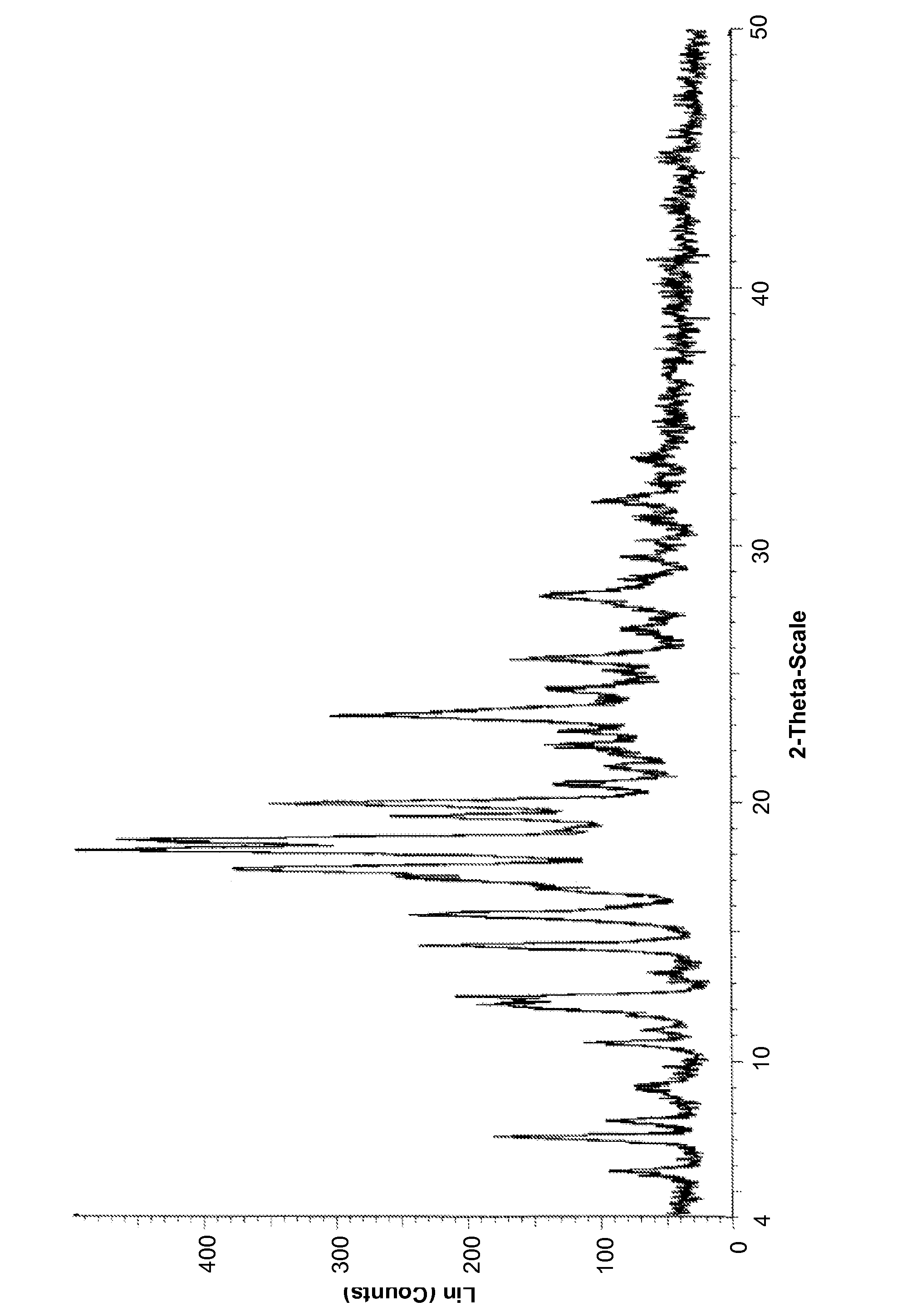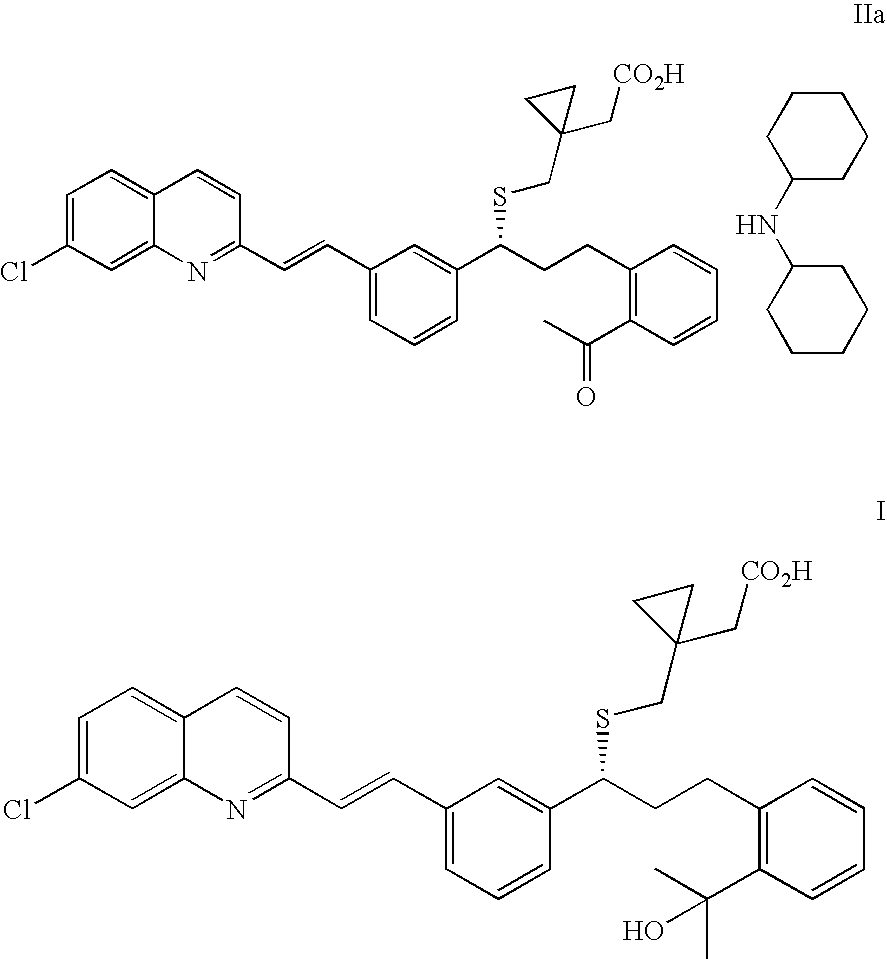Process for preparing a leukotriene antagonist and an intermediate thereof
a leukotriene antagonist and intermediate technology, applied in the field of process for preparing leukotriene antagonists, can solve the problems of low final product yield, hardly applicable industrial scale process, and particularly suitable industrial-scale application, and achieve the effects of reducing the number of reactions
- Summary
- Abstract
- Description
- Claims
- Application Information
AI Technical Summary
Benefits of technology
Problems solved by technology
Method used
Image
Examples
example 1
(S)-(E)-1-(2-(1-(3-(2-(7-chloro-2-quinolinyl)ethenyl)phenyl)-hydroxypropyl)phenyl)ethanone monohydrate (VI)
[0059]To a 1M solution (390 ml) of lithium bis(trimethylsilyl)amide in tetrahydrofuran, 65 ml of a 3M solution of methylmagnesium chloride in tetrahydrofuran were slowly added under N2 atmosphere at a temperature of 0° C. The solution obtained was maintained for 30 minutes at 0-5° C. under stirring. 25 g of methyl (S)-(E)-2-(3-(3-(2-(7-chloro-2-quinolinyl)ethenyl)phenyl)-hydroxypropyl) benzoate monohydrate (3.8% of water, VII, EP 480717, example 146, step 2) were dissolved in 250 ml of toluene. The solution was heated at reflux and water was separated by azeotropic disuntilation at a temperature above 110° C. The solution was concentrated to a volume of approximately 130 ml and the initially prepared reducing solution was slowly added under N2 atmosphere at a temperature from 0° C. to −5° C. After the addition was completed, the reaction mixture was maintained for 15 hours unde...
example 2
(R)-(E)-1-(((1-(3-(2-(7-chloro-2-quinolinyl)ethenyl)phenyl)-3-(2-acetylphenyl)propyl)thio)methyl)cyclopropane acetic acid dicyclohexylamine salt (IIa)
[0063]a) (S)-(E)-1-(2-(1-(3-(2-(7-chloro-2-quinolinyl)ethenyl)phenyl)-1-(methanesulfonyl-oxy)propyl)phenyl)ethanone (IV.1)
[0064]20 g of the compound obtained in Example 1 (4% water, VI) were dissolved in 200 ml of toluene. The solution was heated at reflux and water was separated by azeotropic distillation. The solution was then concentrated to a volume of approximately 50 ml.
[0065]To the solution thus obtained, 8.4 g of triethylamine were added and the mixture was cooled to a temperature from −5 to −10° C. While maintaining this temperature, 7.1 g of mesyl chloride were slowly added and the mixture was stirred for 1 hour at the temperature from −5 to −10° C. under N2 atmosphere. Thereafter, 200 ml of previously cooled acetone were added with stirring for 1 further hour at the temperature from 0 to −5° C. The solid present in the react...
example 3
(R)-(E)-1-(((1-(3-(2-(7-chloro-2-quinolinyl)ethenyl)phenyl)-3-(2-(1-hydroxy-1-methylethyl)phenyl)propyl)thio)methyl)-cyclopropane acetic acid sodium salt (Montelukast sodium salt, Ia)
[0074]In a light-protected flask under N2 atmosphere, 10 g of the compound obtained in Example 2, 100 ml of toluene and 50 ml of water were placed. 1 g of glacial acetic acid was added and the mixture was kept under stirring until obtaining a solution. The aqueous phase was separated and the organic phase was washed with two 50-ml portions of water. Water was removed from the resulting solution by azeotropic distillation and the solution was concentrated until obtaining a residue which was dissolved in 50 ml of tetrahydrofuran.
[0075]In parallel, a mixture of 2.9 g of anhydrous cerium (III) chloride and 50 ml of tetrahydrofuran was prepared and kept at reflux temperature for 1 hour. The mixture was then cooled to 0-5° C. and 17.5 ml of a 3M solution of methylmagnesium chloride in tetrahydrofuran was adde...
PUM
| Property | Measurement | Unit |
|---|---|---|
| temperatures | aaaaa | aaaaa |
| temperatures | aaaaa | aaaaa |
| temperature | aaaaa | aaaaa |
Abstract
Description
Claims
Application Information
 Login to View More
Login to View More - R&D
- Intellectual Property
- Life Sciences
- Materials
- Tech Scout
- Unparalleled Data Quality
- Higher Quality Content
- 60% Fewer Hallucinations
Browse by: Latest US Patents, China's latest patents, Technical Efficacy Thesaurus, Application Domain, Technology Topic, Popular Technical Reports.
© 2025 PatSnap. All rights reserved.Legal|Privacy policy|Modern Slavery Act Transparency Statement|Sitemap|About US| Contact US: help@patsnap.com



